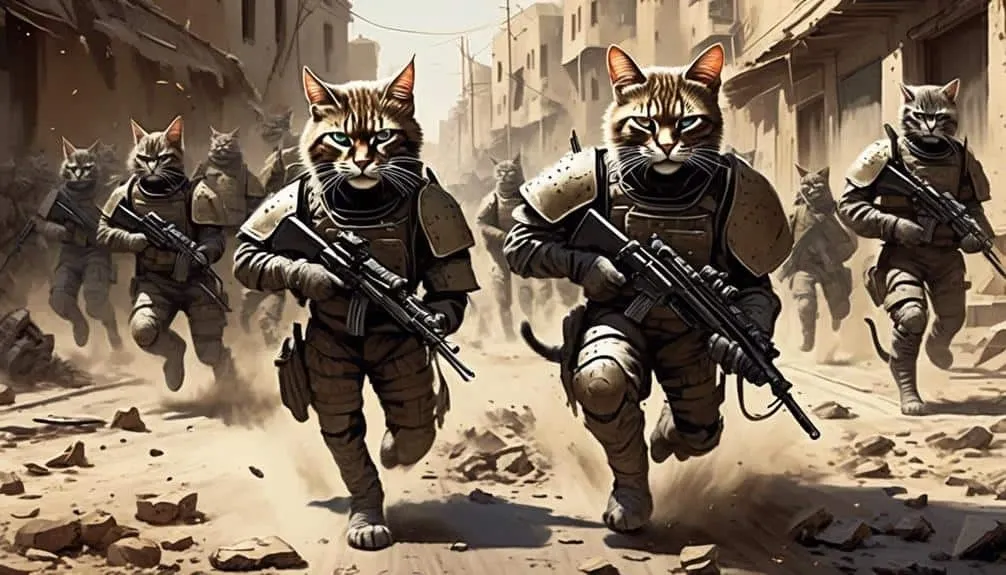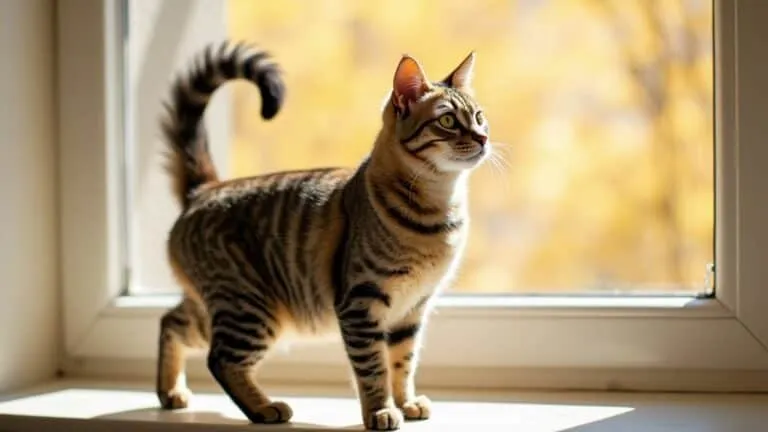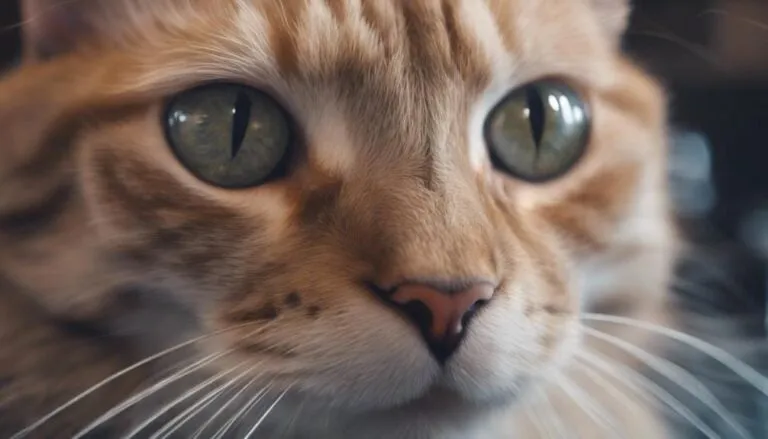The Best Fluffy Pancakes recipe you will fall in love with. Full of tips and tricks to help you make the best pancakes.

As the sun sets over the battlefield, a sleek shadow silently prowls through the grass, its eyes gleaming with a predatory intensity. In the realm of warfare, where strength and strategy reign supreme, an unlikely contender emerges: the feline.
With their agile bodies and deadly arsenal, cats possess a unique set of skills that make them a force to be reckoned with. But how do they fare against their canine counterparts? And what about their prowess when pitted against humans?
In this article, we will explore the untapped potential of these seemingly innocent creatures, unveiling their true power in the art of feline warfare. Prepare to witness a battle like no other, where the untamed ferocity of the feline warriors shall be unleashed.
Key Takeaways
- Cats have strong and flexible bodies, quick reflexes, and sharp teeth and claws, making them tough and capable hunters.
- Cats have advantages in a fight against dogs, using their quick sprinting and jumping abilities to escape and disabling dogs by blinding them and hurting their nose.
- Domestic cats have strong hind legs for jumping, while larger wild cats have relatively weaker hind limb muscles and are more aggressive by nature.
- While cats cannot overpower humans due to their smaller and less powerful skeleton, they can cause harm if they attack. Cats' evolutionary advantage lies in their agility, size, stability, and ability to form bonds with humans.
Cats' Physical Abilities and Strengths
Cats possess a remarkable array of physical abilities and strengths that enable them to navigate their environment with unparalleled agility and prowess.
Their hunting prowess is a result of their strong and flexible bodies, quick reflexes, sharp teeth, and retractable claws. These physical attributes allow cats to be tough and capable hunters.
In addition, cats have the ability to jump about six times their height, showcasing their impressive agility. Their strong sense of smell, excellent vision, and broad hearing range further enhance their hunting abilities.
Cats' flexibility also plays a crucial role in their hunting success, as it allows them to escape stronger opponents and attack with speed and ferocity.
These physical abilities and strengths make cats formidable predators in their natural environment.
Cats Vs. Dogs: Battle of the Fur
In the battle of the fur, dogs and cats exhibit distinct characteristics and abilities that contribute to their unique strategies and chances of success in combat.
- The psychology behind cat-dog interactions:
- Cats are known to be more independent and territorial.
- Dogs, on the other hand, are pack animals and seek social interaction.
- Understanding these psychological differences can help in managing their interactions and reducing conflicts.
- The role of training in cat-dog coexistence:
- Proper training is essential for both cats and dogs to coexist peacefully.
- Positive reinforcement techniques can be used to teach them appropriate behaviors.
- Training can help dogs learn to respect a cat's space and discourage chasing.
- Similarly, cats can be trained to tolerate the presence of dogs and feel more secure in their presence.
Domestic Cats Vs. Wild Cats: a Clash of Instincts
Understanding the psychological differences between cats and dogs can shed light on the clash of instincts that occurs between domestic cats and their wild counterparts.
Domestic cats, despite their domestication, still retain many of their wild instincts. One such instinctual conflict arises from territorial behavior. Wild cats, such as lions and tigers, have vast territories that they fiercely defend against intruders. This territorial instinct is deeply ingrained in their nature and drives them to mark their territory and engage in aggressive encounters with other cats.
On the other hand, domestic cats, while still possessing a territorial nature, have smaller territories and are less aggressive towards intruders. This clash of instincts can lead to tension and conflicts when domestic cats encounter their wild counterparts, as they both instinctively defend their territories.
Cats Vs. Humans: Unleashing the Feline Fury
With their strong and flexible bodies, sharp teeth, and retractable claws, cats possess a formidable set of physical attributes that can make them a force to be reckoned with in their interactions with humans. When it comes to cat-human interactions and the psychology of cat attacks, several factors come into play.
First, cats have a strong predatory instinct, which can be triggered by certain stimuli or perceived threats. This means that even domesticated cats may exhibit aggressive behavior towards humans, especially if they feel threatened or cornered.
Second, the size and strength of humans can make it difficult for cats to overpower them. While cats can cause harm with their bites and scratches, they're generally unable to overpower a human in a physical confrontation.
Understanding the psychology behind cat attacks can help humans navigate these interactions more effectively. By recognizing and respecting a cat's boundaries, providing them with appropriate outlets for their energy and predatory instincts, and engaging in positive reinforcement training, humans can help foster a safer and more harmonious relationship with their feline companions.
The Evolutionary Advantage of Cats
Cats' evolutionary advantage lies in their specialized physical adaptations and their ability to form unique bonds with humans.
Cats have developed a range of evolutionary adaptations that contribute to their survival strategies. Their strong and flexible bodies, quick reflexes, sharp teeth, and retractable claws make them efficient hunters. Cats' agility allows them to escape stronger opponents and attack with speed and ferocity. Additionally, their strong sense of smell, excellent vision, and broad hearing range enhance their hunting and survival capabilities.
Cats' ability to form bonds with humans is also a significant advantage. This unique bond provides cats with a reliable source of food, shelter, and protection. It's through this partnership that cats have thrived and adapted to various environments, making them successful predators and companions to humans.
Harnessing the Power of the Purrfect Partner
Harnessing the innate strengths of domestic cats can provide humans with a formidable and versatile partner. Training techniques for enhancing a cat's natural abilities are crucial in unlocking their full potential. By understanding the history of cats' hunting instincts in warfare, humans can develop strategies to effectively utilize their skills on the battlefield.
Training Techniques for Enhancing a Cat's Natural Abilities:
- Positive reinforcement: Rewarding desired behaviors encourages cats to repeat them.
- Target training: Teaching cats to touch specific objects or perform actions on command enhances their coordination and focus.
- Agility training: Creating obstacle courses that challenge cats' agility and speed helps improve their physical abilities.
- Hunting simulations: Engaging cats in interactive play that mimics hunting stimulates their natural instincts and sharpens their hunting skills.
Exploring the History of Cats' Hunting Instincts in Warfare:
- Cats have a long history of being utilized in warfare due to their hunting instincts.
- Ancient civilizations, such as the Egyptians and Romans, recognized the cats' ability to catch pest animals and guard against vermin.
- Cats were often deployed on ships to control rodent populations and protect food supplies.
- Their stealth, agility, and hunting prowess made them effective in covert operations and ambushes.
- Cats' keen senses and ability to navigate difficult terrains made them valuable assets in reconnaissance missions.
Harnessing the power of cats as partners requires understanding their natural abilities and employing appropriate training techniques. By tapping into their hunting instincts and leveraging their historical role in warfare, cats can be valuable allies in serving human needs.
Frequently Asked Questions
How Do Cats' Physical Abilities Compare to Those of Other Animals?
Cats' physical abilities, compared to other animals, are impressive. They possess strong bodies, quick reflexes, sharp teeth, and retractable claws. Their agility and speed give them an advantage in sprinting, pouncing, and hunting.
What Are the Main Differences in Fighting Tactics Between Cats and Dogs?
In the art of feline combat, cats and dogs employ different battle tactics. Cats rely on their agility, quick sprinting, and jumping abilities to escape and disable dogs, while dogs depend on endurance and teamwork.
Can Domestic Cats Exhibit Any Aggressive Behavior Like Their Wild Counterparts?
Domestic cats, like their wild counterparts, can exhibit aggressive behavior due to their innate predatory instincts. While they may not possess the same level of aggression as wild cats, they still retain the ability to display aggression when threatened or provoked.
How Does the Skeletal Structure of Cats Compare to That of Humans?
Cats' skeletal structure differs from humans in size and power, but both share similarities. Cats' flexibility and agility are unmatched, allowing them to excel in speed and quick movements compared to other animals.
What Are Some of the Evolutionary Advantages That Have Contributed to the Success of Cats?
Cats' evolutionary advantages include social behavior and hunting techniques. Their ability to form bonds with humans gives them an advantage, while their agility and predatory skills make them successful hunters in various environments.
Conclusion
In conclusion, cats possess a remarkable set of physical abilities and strengths that make them formidable warriors in the world of feline warfare. Despite their smaller size, they excel in agility, strength, and cunning, allowing them to hold their own against their canine counterparts and even humans.
While some may argue that their domestication has weakened their wild instincts, it's important to recognize that cats have evolved to adapt and thrive in various environments. The untapped potential of these seemingly innocent creatures shouldn't be underestimated.








